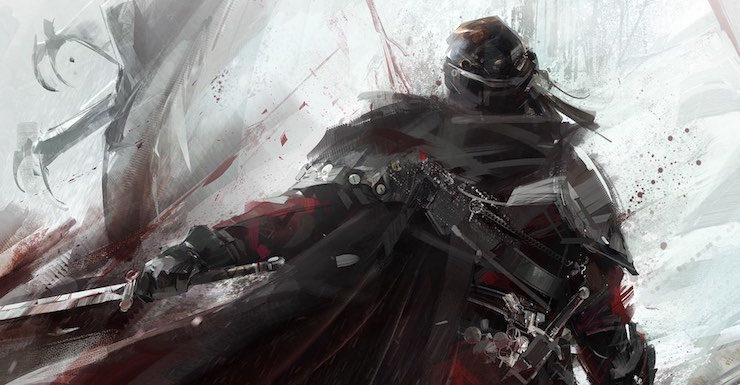I live in Ireland, where at this time of year it starts to get dark at four p.m., and on rainy grey days—we have a lot of rainy grey days—it can sometimes feel as though the sun hasn’t come up at all.
I put effort into managing my depression at the best of times. In the last couple of years, managing my depression has been complicated by the need to manage a growing amount of anxiety (which sometimes makes concentrating on anything other than not tearing off my own skin difficult). And with the relentless march of holiday-themed merchandise and advertising kicking my financial anxiety into higher-than-usual gear, I want to take this opportunity to look back on the narratives that 2017 gave me that have proved… sustaining, in more ways than one. Art is what keeps me going, most of the time. Art is what gives me hope. (Though most of the people who make it will sympathise with my financial anxiety: the vast majority of writers are shockingly underpaid for the amount of benefit they bring to the world.)
For me, the real surprise of 2017 has been television. In particular, Star Trek: Discovery, whose new episodes appear once a week on Irish Netflix. It’s been a while since I watched a show as a serial rather than an endurance event, and having time to breathe between each new episode makes a palpable difference. I know there are criticisms to be levelled at Discovery (Michelle Yeoh’s departure after two episodes was gutting), but Sonequa Martin-Green’s performance as disgraced Starfleet officer Michael Burnham is utterly amazing, as is Discovery’s choice to prioritise Michael’s point of view over a more ensemble focus. Though the ensemble also has some brilliant elements: I’m thinking in particular of the relationship—the love—between Lt. Paul Stamets (Anthony Rapp) and Dr. Hugh Culber (Wilson Cruz). We’ve yet to see a tentpole franchise film—whether Star Trek, Star Wars, or any of the comic book movies—explicitly feature a queer relationship. It shouldn’t be gratifying to see queerness on Discovery in this day and age, and yet it is.
And the mid-season cliffhanger is a hell of a cliff.
I did watch season one of Wynonna Earp as an endurance event, huddled on the couch with my girlfriend over the course of a weekend. It’s a show that’s aware of its own ridiculousness: several male characters take their shirts off for dramatic emphasis, its main character Wynonna (one of “those Earps”) swigs whiskey from the bottle when trying to explain that things happen because demons, and a resurrected/immortal (distressingly hot) Doc Holiday might take off his waistcoat, but he’ll never leave his hat behind. The plot holes are… not miniscule. But the dialogue snaps and crackles, and the show features a very touching romance between Wynonna’s younger sister Waverly and Sheriff’s Deputy Nicole Haught—a woman who knows how to rock a cowboy hat. The show is just ridiculously fun, and I’m looking forward, one day, to being able to watch season two.
When it comes to books, 2017 has been full of outstanding examples. Perhaps a little too full for me to remember them all: I’ve already talked about some of the really good examples of queer science fiction and fantasy this year in “My Year in Queer” and how that made me feel. I’m still not entirely sure how to quantify my reaction in critical terms to the increase in queer-friendly narratives, but emotionally, there’s something incredibly reassuring and comforting about it, like hearing the murmur of a community saying You belong. There’s space for you if you want it.
The books that I come back to from 2017, the books that made me happiest, might not be the obvious examples. Aliette de Bodard’s The House of Binding Thorns is not, for most of its length, particularly uplifting. But it’s gorgeously written and excellently characterised, and its viewpoint characters are people who’re doing their best to navigate the constraints on their lives with empathy and grace, who’re doing their best to build and protect, rather than destroy.
Tim Pratt’s The Wrong Stars is also enormously fun, a wonderfully modern take on pulp space opera. Reading it cheered me deeply at a time I needed to be cheered. Alex Wells’ Hunger Makes The Wolf and Foz Meadows’ A Tyranny of Queens rounds out the Angry Robot Books’ entries in the things that made me happy column. For excellent paired reading, K. Arsenault Rivera’s epic fantasy love story The Tiger’s Daughter goes well with Elizabeth Bear’s epic fantasy The Stone in the Skull, as both settings take their inspiration from Central Asia and parts east. Robyn Bennis’s The Guns Above‘s cheerfully grim gallows humour (with airships!) is a definite winner, as is Max Gladstone’s latest Craft novel, Ruin of Angels, which delves deep into history, memory, postcolonialism, and who gets to define or legitimate both past and present.
Life is good. Art is good. Winter, like so many other kinds of darkness, is temporary. Beyond the darkness, there’s a whole new year.
What are you looking forward to that’s in it?
Liz Bourke is a cranky queer person who reads books. She holds a Ph.D in Classics from Trinity College, Dublin. Her first book, Sleeping With Monsters, a collection of reviews and criticism, is out now from Aqueduct Press. Find her at her blog, where she’s been known to talk about even more books thanks to her Patreon supporters. Or find her at her Twitter. She supports the work of the Irish Refugee Council and the Abortion Rights Campaign.










